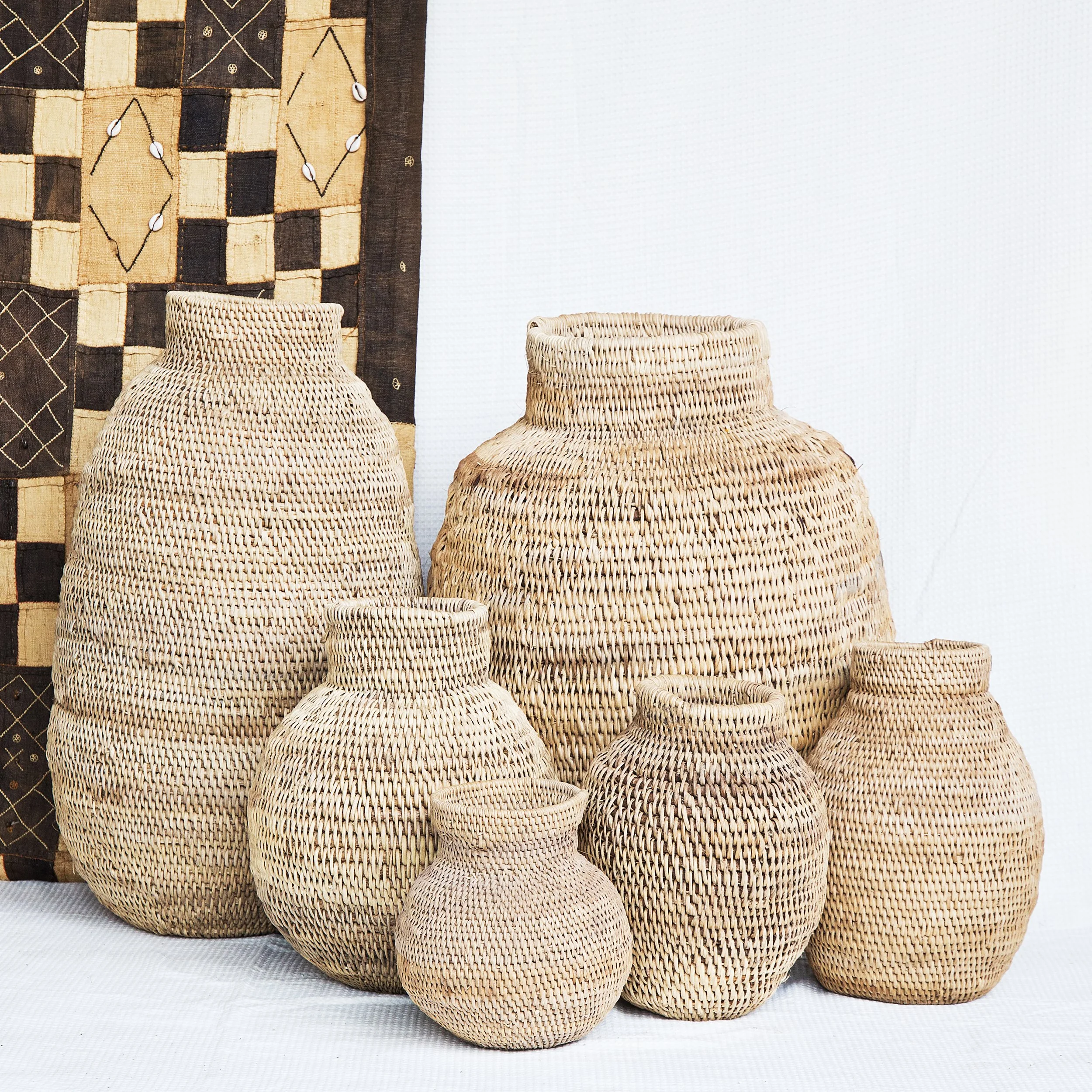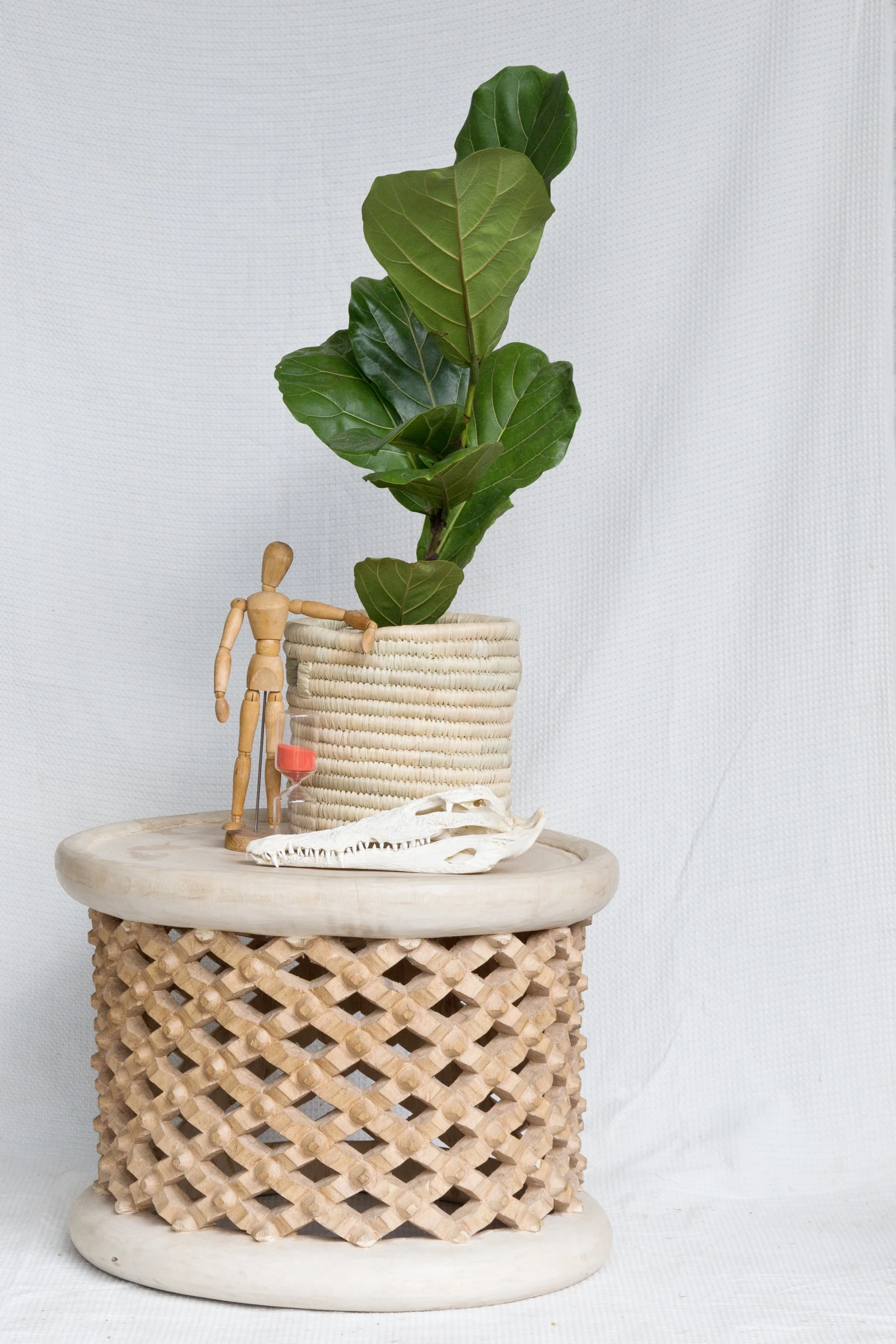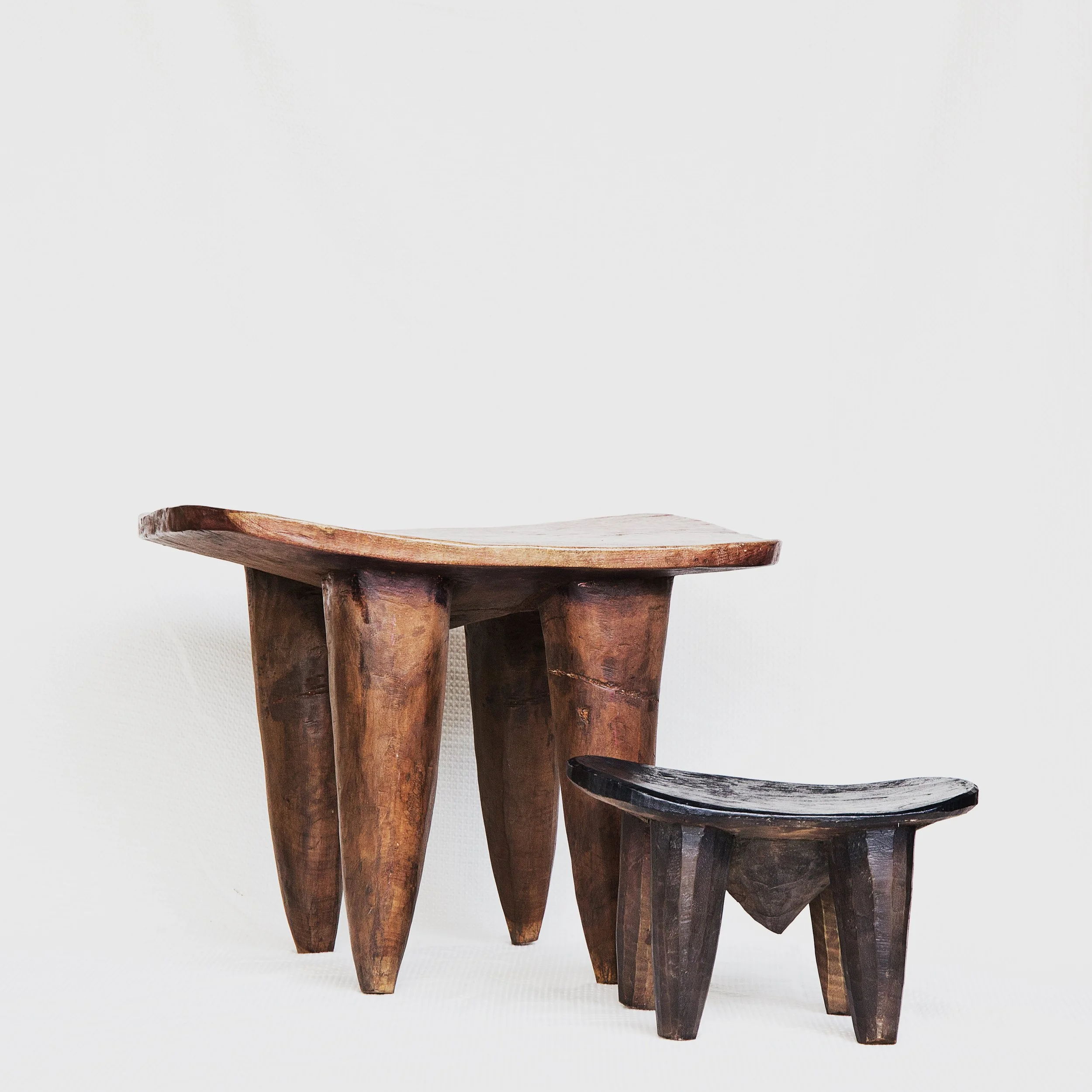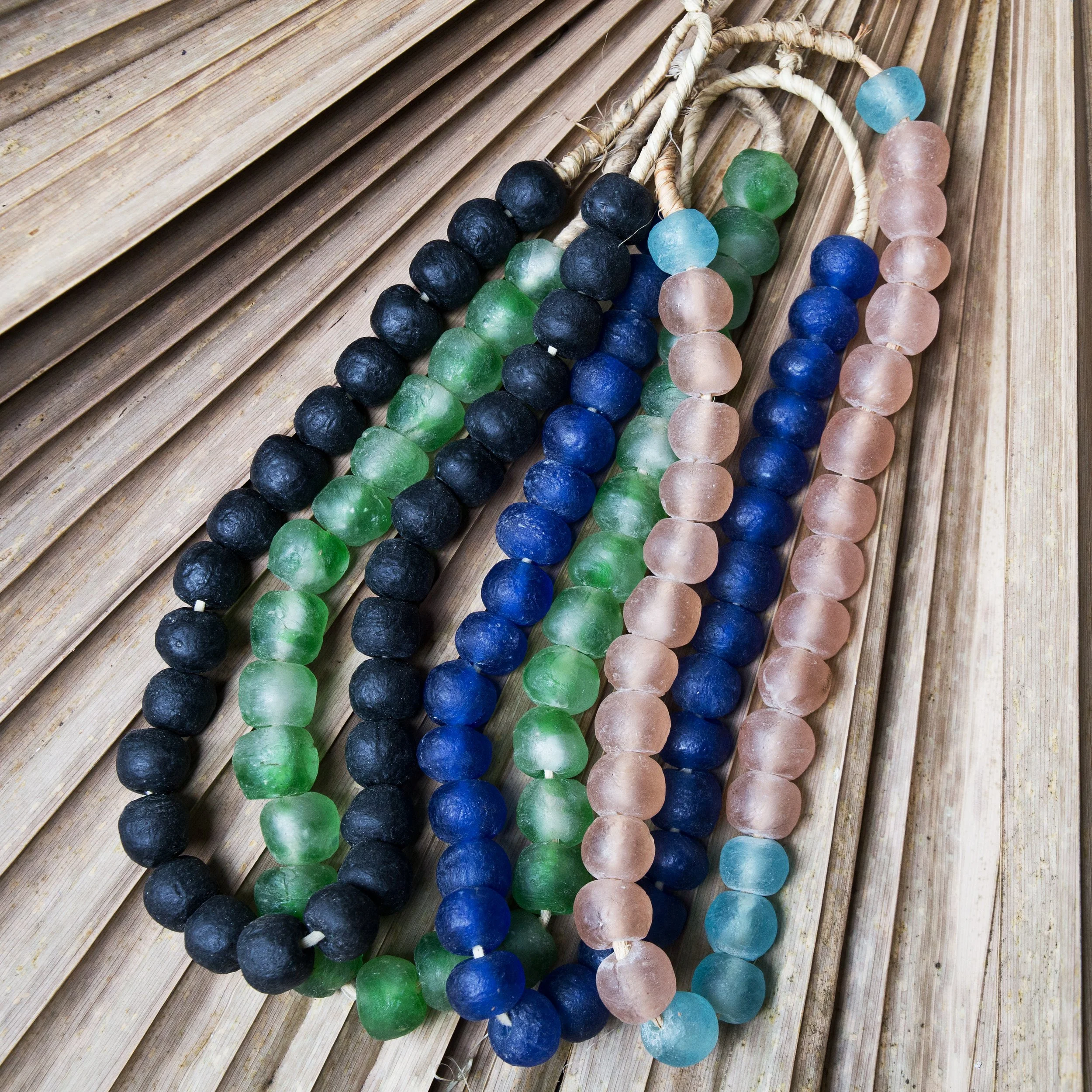Our Collection.
Glimpses of history resonate in the contours of these artefacts—each stroke of the artisan's hand tells a story of resilience, of centuries-old traditions passed down through generations. The intricate carvings, vibrant colours, and meticulous designs are not just decorative elements but echoes of a bygone era, encapsulating the spirit and soul of African culture.
What you see here is just a fraction of the African artefacts available for purchase, so please get in touch if you would like to see more of the collection.
Baskets.
The significance of basket weaving transcends its practical purpose. It is a communal endeavor, fostering bonds and shared experiences. Elders pass on their knowledge to the younger generation, imparting not just weaving techniques but the values, stories, and customs ingrained within each intricate pattern.
Garlic baskets.
Handcrafted with the delicate and textured ilala palm. These pieces may stand alone or clustered to provide visual interest and warmth to any room thanks to their organic and whimsical forms. The size, weaving, and color of each basket is unique.
Makenge baskets.
Making use of the roots of the Makenge bush, these baskets were first used for the purpose of sifting maize. They were crafted by the women of the Mbunda people, who are indigenous to Zambia. Each one is unique in terms of its dimensions, hues, and patterns.
Senegal baskets.
These baskets are a tribute to the Senegalese community that weaves them; the use of recycled plastics and palm in their construction allows for vivid color combinations. Everything from placemats to laundry baskets comes in an infinite variety of shapes and sizes.
More baskets…
Buhera baskets.
From the village of Buhera in Zimbabwe, these baskets are hand woven by a community of women using indigenous creeper vines. Traditionally used to store grain. Sizes, colours and weaves vary.
Vintage Makenge baskets.
In Zambia, new brides are gifted a handwoven basket fashioned from Makenge bush roots, which is a centuries-old custom. Often, the baskets are passed down to the bride by her mother or in-laws, and she will pass the basket on to her own newly married daughter. Sizes, weaves and colours vary.
Tonga baskets.
These magnificent baskets, created by the BaTonga people of Zimbabwe's Binga area, represent the peak of their skill. A woven basket begins as a square and ends in a rounded form. Their natural colours add to their artistic character, and their intricate patterns are so unique, each one a piece of beauty. Available in various sizes.
And more baskets…
Vintage Tonga baskets.
These exquisite antique hand-woven baskets are called after the secluded Binga region, home to the exiled Batonga tribe. Today, many Tonga women weave these beautiful baskets using traditional methods. The baskets are made from indigenous wild grasses, tiny vines, and palm leaves. Sizes, colours and weaves vary.
Zambia storage Baskets.
Made by the women of Zambia using native plant materials, these baskets are a wonderful way to bring texture and warmth into any room in your home. They are versatile for storage and decoration since they come in a wide range of sizes and forms.
Zambia multi colour baskets.
These baskets are made from natural grasses and adorned with flashes of color from recycled plastics and materials, both visually striking and a reflection of the ongoing environmental conservation efforts of the women's community in Zambia.
Stools.
An enduring icon of African culture, the seemingly little stool embodies a heritage that has no bounds. The stool is more than just a seat; it is a sacred relic that, in its understated yet painstakingly made shape, contains the knowledge, spirituality, and tradition of ages past.
African civilizations place great historical value on these stools, which are crafted from wood with elaborate patterns and decorated with symbolism. They are symbols of prestige, tradition, and power, and not only practical things.
Ashanti stool.
This stool is seen as a symbol of authority, power, and accomplishment in Ashanti culture. Additionally, it serves as a means of preserving the cultural heritage of the user. In order to honor the wood and the natural sacrifice it represents, it is customary to perform rituals that glorify the trees that will be carved. In both form and meaning, the Ashanti stool's shape provides a warm embrace and a safe haven for the spirit. The etchings and motifs on the stool also symbolize the owner's accomplishments. Sizes Vary.
Nupe stool.
Meticulously hand-carved from solid wood by the Nupe people of Nigeria, these stools are traditionally given as a symbol of love and commitment by a groom to his bride. Nupe stools are crafted in different styles from solid African hardwood. Each stool features a beautifully carved top surface adorned with intricate patterns and occasionally painted in vibrant colors. Sizes vary.
Bamileke stool.
The Bamileke stool, also known as the "King's Stool," is truly a masterpiece. The level of artistry and dedication required to meticulously hollow out a single tree trunk is truly remarkable. With its beautifully crafted design on the outside, every stool has its own unique charm. As a natural product, it embraces its imperfections, making it even more special. Offered in a wide range of designs, sizes, and colors.
More stools…
Senufo stool.
Crafted by hand from a single piece of indigenous hardwood by the Senufo people of Ivory Coast. The design features a gracefully curved surface and elegantly tapered legs. The understated design and weathered patina on the wood give it a unique charm that can elevate the look of any room. Available in various sizes.
Baga Stool.
These remarkable pieces are hand sculpted from a single piece of solid wood by the talented tribe of Baga Guinesa-Bissau of Guinea. Their motifs depict serpent figures characteristic of Baga craft. Available in various sizes.
Tonga stool.
Zimbabwe is the birthplace of these Tonga stools, which are crafted by hand from a single piece of wood. These stools are also known as Batonga or Tonga stools because the Batonga people of Binga handmade them. Aristocrats, elders, and nobles would traditionally utilize these stools as a makeshift seat due to their portability and low weight. Available in various sizes
Pottery and Ceramics.
The art of pottery-making in Africa transcends mere functionality; it is a canvas that captures the essence of a people's identity. Passed down through generations, the techniques and designs reflect a deep-rooted connection to the land, history, and the vibrant tapestry of beliefs and traditions.
Shona Pot.
These “hari”, or clay pots, were primarily used for cooking purposes. The capacity to seize opportunities was symbolized by owning one. Women of the Shona ethnic group in Zimbabwe are largely responsible for developing and producing pots. There are several types, each with unique names, designed for a certain use. The pots are baked in pits over fires made of dried cow dung (ndove) until it solidifies. Various sizes and designs available.
Zulu pot.
The Zulu pot (Ukhamba) is crafted with great care to fulfill its purpose of brewing, drinking, and ceremonially serving beer. This event holds great significance in the Zulu culture of South Africa, serving as a cherished tradition that brings people together. These beauties have gained recognition as cherished handcrafted collectibles, showcasing elegant simplicity and distinctive handmade patterns and decorations that are rooted in family and regional traditions. Various sizes and designs available.
Beads.
As time unfolds, the legacy of trade beads endures—a testament to the ties forged through commerce and cultural exchange over centuries. They remain more than mere artefacts; they are tangible links to a history of shared experiences, trade networks, and the richness of African cultural heritage.
Recycled glass beads.
The Krobo community of Ghana have a rich bead-making history. Glass beads were used for commerce while also playing a significant part in cultural expression, style, and showcasing affluence. Each bead is individually moulded. Glass is powdered, then subjected to intense heat in clay kilns, and finally refined using sand for a smooth finish. Recycled glass beads hold a special significance in Ghana's rich cultural heritage and evoke a deep sense of pride among those who adorn them. Available in various sizes and colours.
Bone beads.
Bone beads represent Africa's rich cultural heritage, embodying the value of resourcefulness and sustainable living. Throughout Africa, the tradition of crafting beads from animal bone has been passed down for generations, and it remains a cherished practice to this day. In the past, these beads held great value and were often exchanged for essential items like food and other goods. The beads are crafted and shaped by highly skilled artisans from Kenya.
Brass beads.
Brass casting in Ghana and Ivory Coast (Côte d'Ivoire) has a rich history that spans many centuries. In modern times, Krofofrom near Kumasi in the Ashanti Region of Ghana has become a significant hub for brass bead-making.The artisans in the Ashanti Region of Ghana use a traditional method called the "lost-wax" method to cast brass. This process entails creating a model using beeswax that, when heated, melts away, leaving behind a hollow space that can be filled with molten metal, specifically brass. This technique has been passed down through generations and is cherished by both the Ashanti and Baule people.
—





















